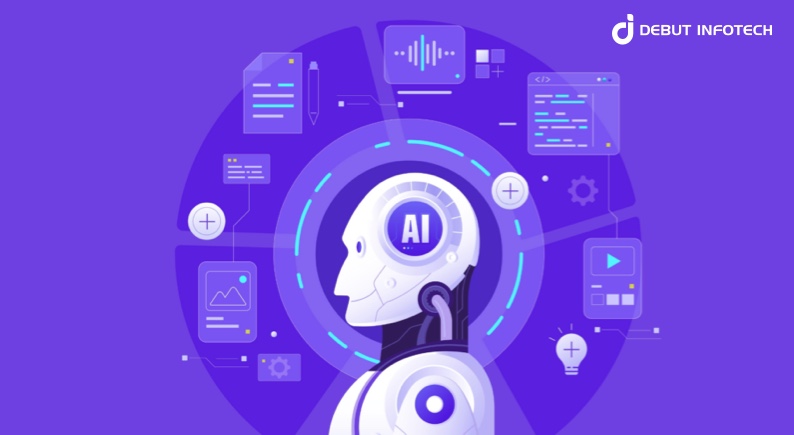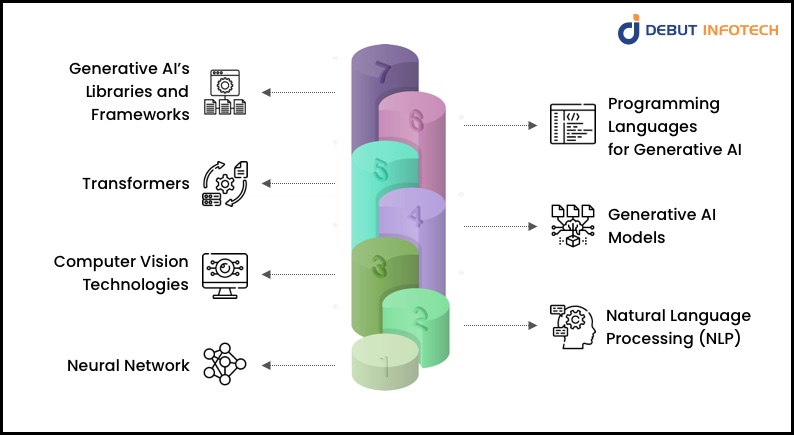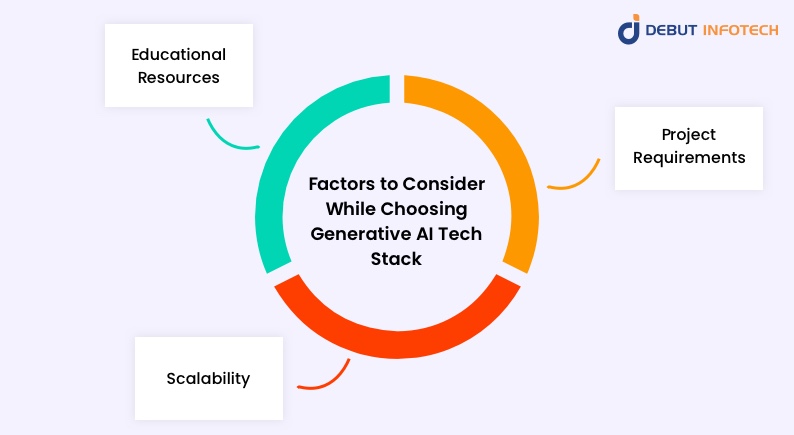Table of Contents
Home / Blog / AI/ML
The Ultimate Guide to Building a Generative AI Tech Stack
March 29, 2024

March 29, 2024
Artificial intelligence is at the forefront of technological innovations. With multiple groundbreaking applications, generative AI has ignited an impactful change in how we interact with everything. From medical care to financial technology (FinTech), AI is the foundational technology with an essential generative AI tech stack.
According to a report on Statista, the adoption rate of AI in businesses and other sectors is expected to reach up to 49 percent by 2025, making it one of the most important technological innovations. It reflects the widespread acceptance of technological excellence that AI offers.
Generative AI is somewhat different from traditional AI regarding usability and applications. While traditional AI is excellent in analysis and prediction, generative AI gets the hang of creating novel and developing applications, including content, graphics, new computer programs, etc. This article will guide you through the essential AI tech stack to become efficient in generative AI and contribute to AI use cases that enhance business operations.
Generative AI Tech Stack – An Overview

Before we explain the generative AI tech stack, here is a quick explanation of generative AI technology to help you understand this revolutionary technology well. As its name is self-explanatory, generative AI refers to using AI systems to create new data, content, and media using a pre-trained system. The generated content is unique due to the AI system’s cognitive abilities and machine learning technology.
The AI stack is a list of tools and technologies a person learns and masters to understand the existing AI technologies. It also helps AI developers bring new AI systems to the world, helping enterprises and businesses enjoy versatile and extensive features. Therefore, learning about a few popular and essential tech stacks that will aid you in your AI development journey is vital.
Research finds that generative AI will become a 1.3 trillion USD market globally by 2032. These statistics show massive room for financial rewards and profits as the corporate and IT sectors embark on accepting generative AI in their business operations. You can also join this lucrative market by mastering this AI stack to stay ahead.
Importance of AI Technology Stack
A reputed generative AI tech stack is the foundation to dive deeper into understanding and developing industry-standard AI since it gives you access to widespread tools, frameworks, and technologies. It is the first step of you becoming eligible to devise and run generative AI tools and applications.
It is important because a tech stack of generative AI allows you to fill the gap in the market with enough knowledge to deploy standard AI applications for enterprises and organizations. By making you learn the communication of AI models and algorithms, you can achieve flawless deployments of generative AI tools.
Moreover, a well-curated generative AI tech stack will offer you a distinctive position in scaling and future-proofing your projects for smooth business functionality. It safeguards your information from memory limitations, technological redundancy, and other errors. Therefore, getting your hands on a forward-thinking tech stack will boost your AI career.
Breakdown of Generative AI Stack

When you encounter an application of generative AI, such as the renowned ChatGPT, a question may strike your mind. Have you ever wondered what makes this online tool so powerful that it interprets every instruction and generates the results that you want? It is when the role of the generative AI tech stack comes in handy.
Many technologies, frameworks, and models are behind the smooth and seamless working of tools like ChatGPT, DALL-E, and others. We will list the best technologies and techniques that will allow you to develop a lucrative generative AI tool for businesses.
1. Neural Network
You will understand that the AI system works like a human mind with cognitive abilities that function on statistical prediction. It reflects that a certain technology powers the human-like functionality of AI machines. That technology is neural networks, which refer to the architecture beneath the AI models that work identically to human brains.
In the human brain, neurons are intertwined and communicate for a seamless and instant performance. Neural networks in AI systems work the same way, helping AI systems capable of image recognition, predictive analytics, and other tasks like generating content, images, videos, and so on.
2. Natural Language Processing (NLP)
Natural language processing, or NLP, is another essential technology to add to your generative AI tech stack. It is one of the foundational technologies in the AI spectrum with multiple benefits. The basic work of an AI system is to make it understand humans’ interaction with it.
Since NLP works on this side of the AI system, it is key to generative AI’s seamless and proper working. Therefore, you must master natural language processing technology to go ahead in creating feature-rich generative AI tools and applications in multiple industries.
Experts predict that the AI chatbot market will reach around 1.25 billion USD globally in 2025. Chatbots are key to effective customer support and management for enterprises. AI-driven chatbots interact constantly with humans, necessitating an impactful NLP technology.
3. Computer Vision Technologies
Computer vision is an integral technology to add to your generative AI tech stack to stay ahead in the AI landscape. Autonomous and instant images and video creation are key to effective digital marketing and other business operations in generative AI.
Computer vision ensures the effective identification of patterns, objects, and emotions to generate tailored images and graphical content. From image and video generation to facial recognition, image-to-image translation, and style transfer, computer vision is key to the visual usability of generative AI.
Computer vision technology works the same way as the human brain in identifying patterns and objects. When a user feeds an input to the AI system, it uses its sensing devices to process and interpret the object, helping the computer identify the object. Thus, generative AI tools use computer vision to generate results based on the prompts or commands.
4. Generative AI Models
Learning about generative AI models is key to becoming a successful AI developer. With multiple AI models, learning the most effective ones is important to save time and energy and become an excellent AI developer.
You can add multiple AI models into your generative AI tech stack, including Generative Adversarial Networks (GANs), Long Short-Term Memory Networks (LSTMs), Variational Autoencoders (VAEs), and transformers.
Moreover, large language models (LLMs) are widely accepted AI models that almost every generative AI tool uses. For instance, OpenAI’s ChatGPT has a robust LLM behind its working with enough data and knowledge bases that ChatGPT can never run out of information. It also powers an AI system to process stored data and produce results for users, facilitating healthcare, autonomous vehicle manufacturing, customer support, etc.
5. Transformers
A kind of deep learning model architecture with a design to tackle sequential textual data, transformers are effective and faster training models in the generative AI landscape. Its efficient working style has gained popularity in generative AI over time, making it a lucrative addition to the generative AI tech stack.
When processing sequential data, such as text, transformers process the data simultaneously without relying on recurrent connections. Though recurrent connections in Recurrent Neural Network (RNN) help in improved data training, transformers like generative pre-trained transformers (GPT) are much faster and more productive when interpreting natural language to generate results based on the data it is trained on.
6. Programming Languages for Generative AI
Many programming languages help in the development of AI tools, including Python, C++, JavaScript, R, Julia, Compute Unified Device Architecture (CUDA), and many more. However, Python is one of the most widely used programming languages by AI research institutions and developers due to its extensive libraries, user-friendly syntax, and matchless community support.
Therefore, you should work on mastering Python in your futuristic generative AI tech stack, as many AI platforms and development applications work on Python. Multiple libraries, including TensorFlow and PyTorch, in the machine learning and deep learning ecosystem demand Python language for working. Therefore, it will skyrocket your career in generative AI development.
7. Generative AI’s Libraries and Frameworks
Libraries and frameworks pave the way for instant and effective AI development. PyTorch and Caffe are some of the best generative AI libraries with industry-standard benefits for AI developers. With its dynamic computation graph, PyTorch is an effective application of the Meta AI Research lab. It eases prototyping and neural network creation, making it an essential application to include in the generative AI tech stack.
With tools, shortcuts, and built-in frameworks, generative AI libraries are essential for smooth and instant AI development and deployment. TensorFlow, Keras, etc., are some of the best platforms for becoming an excellent generative AI developer. These libraries facilitate neural network development for generative AI solutions and applications.
Factors to Consider While Choosing Generative AI Tech Stack

With plenty of options and choices when you add a technology or AI model into your generative AI tech stack, it becomes a challenge to select forward-thinking and modern ones. Given this difficulty, we have come up with a list of factors to consider when you choose a technology for your tech stack.
It will help you succeed in your project and take your AI development to the next level. Here are some of the best components to look after in a technology or generative AI framework before deciding to learn and integrate it into your tech stack.
1. Project Requirements
When choosing a technology, application, or tool for your generative AI tech stack, it is vital to visualize the impact it will have on the project. When you master a tech stack that is enough for any generative AI project, you will be rest assured of the outcomes.
Therefore, you must go on with applications that offer user-friendly interfaces and functionality for a seamless experience with the technology. Moreover, interoperability is another feature that will make your project effective without consuming more time and energy.
2. Scalability
Every business and enterprise looks to upgrade their revenue and sales with innovations. You must look for a generative AI tech stack that can help them in scalability. When you learn a technology that is compatible with other technologies, you will enjoy peace of mind when developing generative AI tools and solutions.
3. Educational Resources
Documentation and educational resources ease learning and mastering a technology and application. Therefore, you should add technology to the generative AI tech stack with ample information and tutorials to facilitate your pursuit.
Conclusion
Generative AI has presented the world with many applications and solutions that ease business operations with a reduction in operational costs and effective customer services. With ChatGPT, DALL-E 2, and other generative AI applications, enterprises enjoy these cutting-edge innovations’ effortless and instant usability. With our listed generative AI tech stack, you can become an industry leader in the generative AI ecosystem.
If you want a company with an expert team to develop a vetted generative AI tool for your company, Debut Infotech is the best choice. We excel in offering top-notch services in the realm of advanced technologies, such as generative AI, blockchain, web3, decentralized apps, etc. You can enjoy a free consultation with our team to learn more about our services.
Moreover, we write comprehensive educational resources and blog posts on our website to help newcomers and established IT enthusiasts in amplifying their knowledge about these subjects. If you want to learn more about AI, blockchain, and other advanced technologies, read our blog posts.
FAQs: Generative AI Tech Stack
A. Based on the four fundamental elements, the generative AI tech stack comprises training data, computer resources, AI models, and AIOps techniques to come up with a robust generative AI solution for enterprises. There are multiple platforms, frameworks, and models included in this stack, but it differs based on the demands of the project, the scalability an organization seeks, and so on.
A. Since the core of generative AI is machine learning and large language models, adding Python to your generative AI tech stack is essential. Python has a revolutionary application in developing and enhancing generative AI, from easy syntax to myriad programmer-friendly libraries and frameworks.
A. Programming and coding are an integral part of AI, whether traditional or generative AI. However, generative AI demands creating new applications, and coding becomes a vital tool to enhance its machine learning and deep learning capabilities. Therefore, you must become an expert in specific programming languages like Python to get a well-established career in generative AI.
A. You can create a generative AI application when you embark on a journey to master the best generative AI tech stack. It will equip you with adequate knowledge and skills to start developing your generative AI-based tools or applications.
A. There are plenty of generative AI tools in almost every industry. A few of the most popular ones include OpenAI’s ChatGPT, DALL-E 2, Anthropic’s Claude 2, etc. While ChatGPT and Claude 2 offer the best content-creating opportunities, DALL-E 2 is your go-to option for art and design.
Talk With Our Expert
USA
2102 Linden LN, Palatine, IL 60067
+1-703-537-5009
[email protected]
UK
Debut Infotech Pvt Ltd
7 Pound Close, Yarnton, Oxfordshire, OX51QG
+44-770-304-0079
[email protected]
Canada
Debut Infotech Pvt Ltd
326 Parkvale Drive, Kitchener, ON N2R1Y7
+1-703-537-5009
[email protected]
INDIA
Debut Infotech Pvt Ltd
C-204, Ground floor, Industrial Area Phase 8B, Mohali, PB 160055
9888402396
[email protected]




Leave a Comment